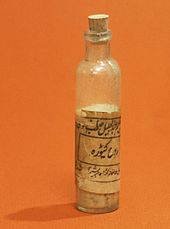 |
| Indian variolation vial with smallpox virus. |
Outbreaks of measles across the globe have once again set off the great debate over vaccination. Since 2014, more than 22,000 cases of measles have appeared in Europe and the World Health Organization recently called for increased vaccination campaigns in the region. In the U.S., measles that began in Disneyland in late 2014 infected more than 150 people.
The development of vaccines and extensive childhood vaccination campaigns are among the most important public health achievements of the past 200 years. They have saved millions upon millions of lives each year and in some cases eradicated dangerous diseases not only locally but globally. The Earth was declared smallpox-free in 1980; in 2000, the United States asserted itself rid of measles.
Despite these successes, the anti-vaccination movement has been gaining traction in recent years, spurred on by religious opposition to vaccines and by the concerns raised by now-discredited studies that linked vaccines and autism. And as vaccination rates decline, the spread of these previously controlled diseases is on the rise.
As we discuss and debate, Origins offers the Top Ten things you should know about vaccines and vaccination efforts.
1. Nasty, Brutish, and Short: Life Before Vaccines
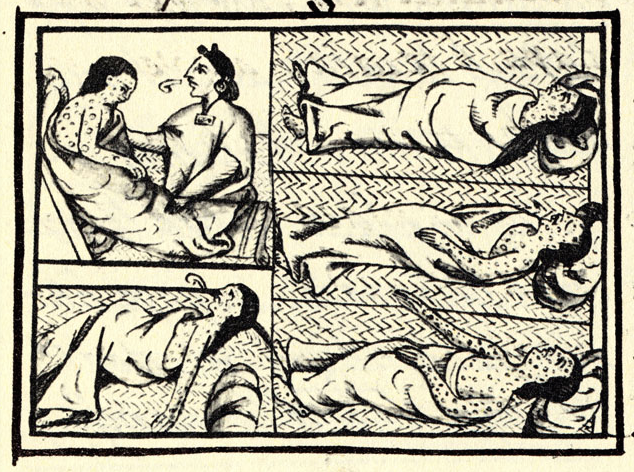 |
| Rendering of the Nahua Population after exposure to Spanish-carried smallpox in Conquest-Era Central Mexico (from the Florentine Codex, a Spanish ethnographic research project). |
Throughout most of history, human populations have lived in an unvaccinated state, and have been extremely vulnerable to endemic and epidemic infectious disease, particularly if they had no previous exposure to a particular disease. This was most spectacularly seen with smallpox in the Americas in the early modern period. Spanish invaders, themselves possessing acquired immunity to smallpox, introduced the disease to indigenous populations, with devastating results. By 1568, the Central American population had fallen to around 3 million, which was around one-tenth of its original population. Before the nineteenth century, the most efficacious way of dealing with epidemic disease was quarantine: the European landscape was littered with pest-houses and lazarettos. Life expectancy was correspondingly low. Global life expectancy was between 25 and 30 years as recently as 1800, and fewer than 5% of most populations survived until sixty-five. People rarely lived to be old.
2. Variolation and the Scourge of Smallpox
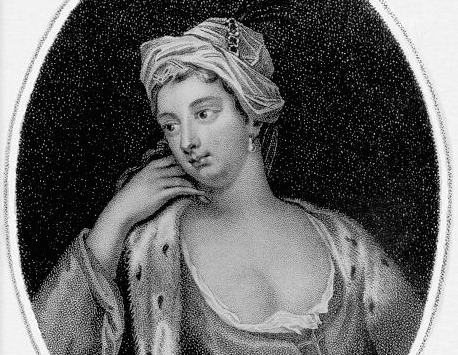 |
| A portrait of Lady Mary Wortley Montagu, who observed the practice of variolation in the Ottoman Empire. |
The origins of vaccination lie in the practice of variolation, which was used to protect against smallpox (a disease that killed annually an estimated 400,000 people in Europe alone in the eighteenth century). Variolation involved transferring disease material from the pustules of an infected to an uninfected person. It was practiced in numerous parts of the world from the early modern period: China, Africa, the Near East and South Asia. It was introduced into Europe by Lady Montagu, who observed the practice in the Ottoman Empire. Her son was inoculated in 1718 and her daughter, Mary, in 1721, the latter being the first person to be variolated in England. Variolation was brought to New England by Cotton Mather and Zabdiel Boylston in 1721. Following the development of vaccination, the practice of variolation declined and was ultimately banned. The British, for example, banned it in 1842. The practice of variolation was eliminated along with the smallpox virus itself in 1980.
3. What We Owe to the Cows
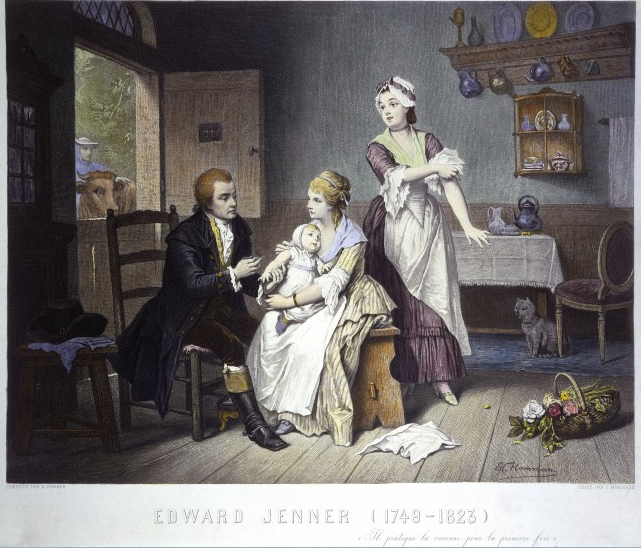 |
| A 19th century colored engraving of Edward Jenner vaccinating his young child as a man stands outside with a cow (from the Wellcome Trust). |
The term vaccination comes from variolae vaccinae, or “smallpox of the cow,” otherwise known as cowpox. The close relationship between smallpox and cowpox was common lore in the eighteenth century. We have accounts of individuals inoculating their children with cowpox pus, for example Peter Plett in Husselburg in 1791. There is also evidence that the practice was known in South Asia and Persia. In 1796, Edward Jenner took cowpox material from the hand of the dairymaid Sarah Nelmes and inoculated James Phipps, the eight year-old son of Jenner’s gardener. He then published his results as An Inquiry into the Causes and Effects of the Variolae Vaccinae, a Disease Discovered in Some of the Western Counties of England, Particularly Gloucestershire, and Known by the Name of the Cow Pox (1798). Jenner did not discover vaccination, but he publicized the technique and proved its effectiveness to doctors.
4. Edward Jenner and the Arm-to-Arm Method
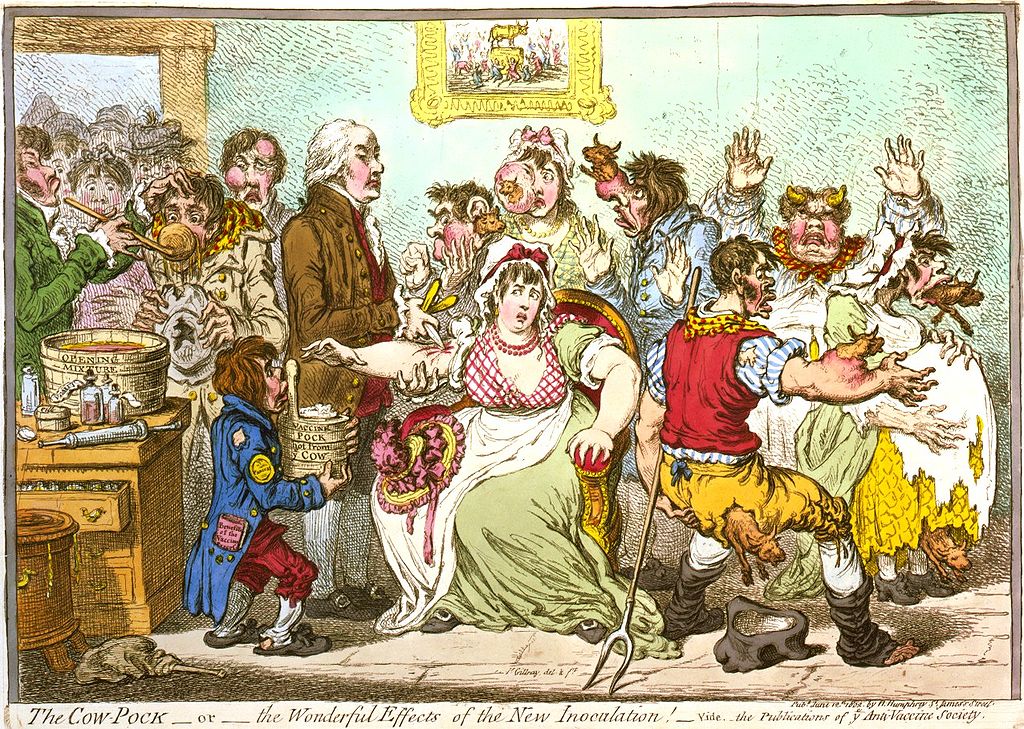 |
| British cartoonist James Gillray satirizes Edward Jenner’s inoculation of the afflicted against cowpox in 1802, rendering them cow-like. |
Jenner was, however, immediately faced with a basic problem. Cowpox was a seasonal disease, common only in the spring, and it was hard to maintain a constant supply of cowpox matter. Hence Jenner developed the so-called “arm-to-arm” method. After vaccination, pustules would erupt on the arm. This pustular material could then be used as a reservoir for another vaccination: it could be extracted from the arm and rubbed into the skin of another patient following mild laceration with a lancet or needle. Jenner could thus maintain a permanent supply of vaccine. The technique spread rapidly: Hanover became the first Continental vaccine center, in 1800. Vaccination spread to the United States (1800), Moscow (1801) and Japan (1824). Some states made vaccination of all children compulsory, for example Bavaria (1807), Denmark (1810), and Sweden (1814). The arm-to-arm method, however, disappeared with the rise of animal vaccines in the 1860s.
5. From Cows to Test Tubes: Producing Vaccines in the Lab
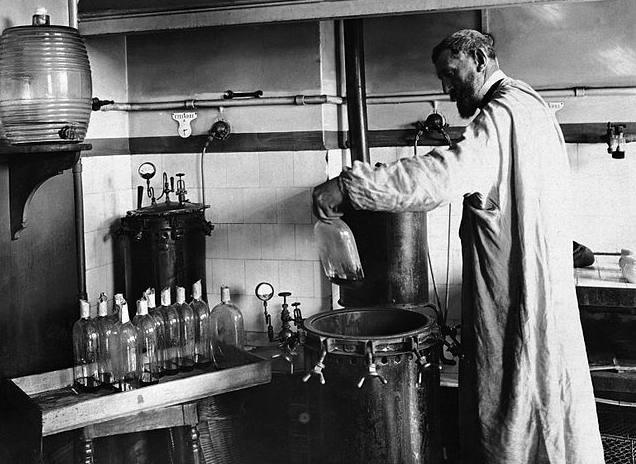 |
| Louis Pasteur photographed working within his laboratory, undated. |
Later in the nineteenth century, scientists began to manipulate pathogens with the aim of reducing their virulence, thereby producing safer and more effective vaccines. This process is particularly associated with Louis Pasteur, who produced the first laboratory-produced vaccine in 1879, for chicken cholera. Although the vaccine was rather ineffective, it heralded a new age of disease control. Jean-Joseph-Henri Toussaint produced an anthrax vaccine in 1880, an invention for which Pasteur later claimed credit. Neither vaccine, however, was used on humans. This changed when Pasteur developed a rabies vaccine after long experiments with attenuation. His vaccination of Joseph Meister in 1885, using material harvested from the spinal cord of rabbits, demonstrated that it was possible to cultivate vaccinations to protect against human diseases.
6. From Hot Irons to Vaccines: Treating Diptheria
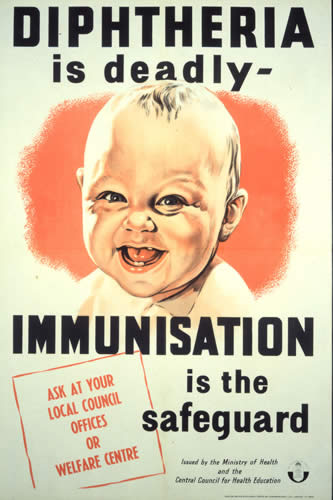 |
| This poster from the United Kingdom, circa 1960, advocates diphtheria immunization. |
Diphtheria was a major killer of children, and treatments were often desperate: sometimes physicians tried to burn away the disease’s characteristic throat pseudomembrane with silver nitrates or even hot irons. Following the discovery of the diphtheria bacterium in 1883, the microbial activity causing the disease was understood. Émile Roux and Alexandre Yersin identified the toxin produced by the bacterium in 1889, and in 1890, Shibasaburo Kitasato and Emil von Behring successfully inoculated guinea pigs with an attenuated, heat-treated diphtheria toxin. Human antitoxins were then successfully utilized, and contributed to the dramatic fall in the disease’s incidence by World War One. After the war, a totally inactivated antitoxin was developed by Gaston Ramon and Alexander Glenny. The combined diphtheria, pertussis, and tetanus (DPT) shot dates from 1948. Today, diphtheria has been practically eliminated from the United States and many other parts of the world.
7. Paralyzed or Worse: Polio
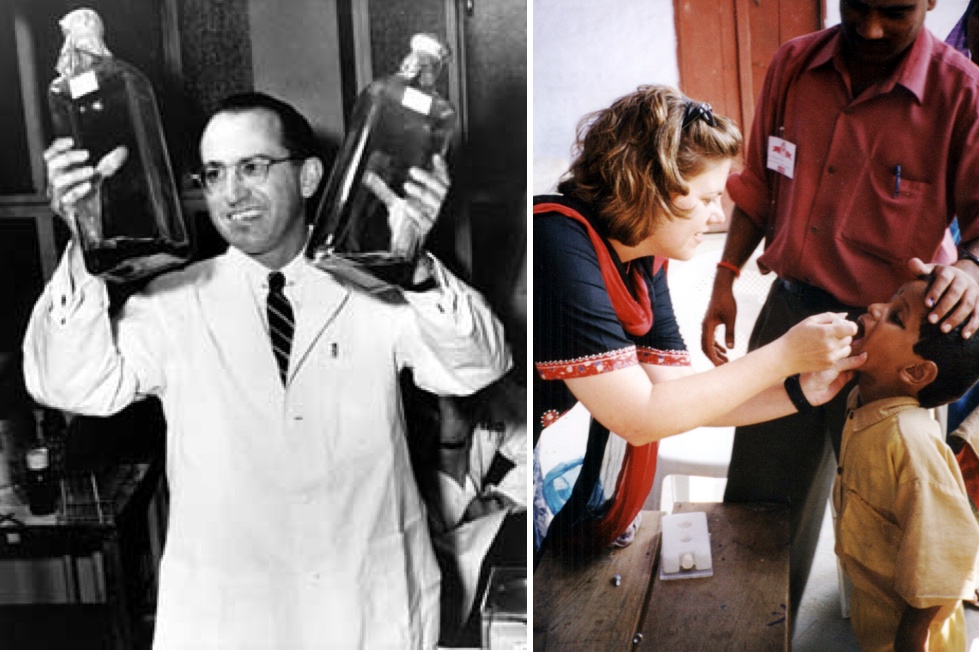
Scientist Jonas Salk raises high two bottles holding the cultures used to grow Polio vaccine in 1955; Photo of oral Polio vaccination in India
Until the early twentieth century, poliomyelitis was an endemic infantile disease, and it became increasingly common as living standards rose. In 1916, a polio epidemic killed 6,000 Americans, and left thousands more paralyzed. American president Franklin Delano Roosevelt was stricken with polio as an adult and spent the rest of his life wearing painful leg braces. In 1929, the iron lung was developed to help sufferers breathe. The first functional vaccines, a killed vaccine pioneered by Maurice Brodie and an attenuated vaccine invented by John Kolmer, were developed in the 1930s. Six of those given the attenuated virus died and tests were immediately suspended. In the 1950s, however, Jonas Salk’s inactivated vaccine proved successful in trials: it was licensed in the U.S. in 1955. Albert Sabin, meanwhile, a Russian-born American scientist, pioneered a successful oral vaccine using an attenuated virus, which was successfully administered to millions of Soviet children in 1959. Sabin’s vaccine was then widely used in the global polio eradication campaign.
8. False Starts: Vaccines that Haven’t Worked
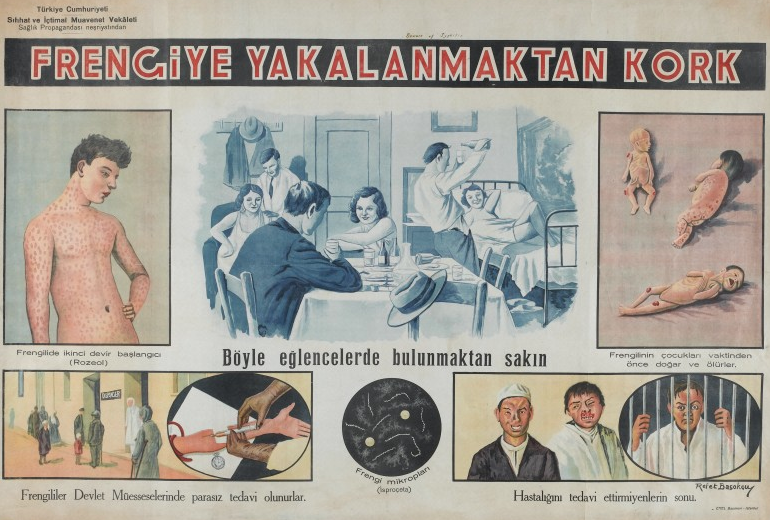 |
| This series of vignettes, published by Turkish Republic Health and Social Assistance Ministry in the 1930s, presents the stages and treatment of syphilis. |
Many diseases have, unfortunately, proved refractory to vaccination. In the mid-nineteenth century, for example, Joseph-Alexandre Auzias-Turenne undertook several experimental “syphilisations” of patients. His work was furthered by an Italian, Sperino, and a Norwegian, Boeck. Although some success was claimed, a functional syphilis vaccine has never been developed. Jaime Ferran’s 1885 cholera vaccine was the first to be used against a human bacterial disease. However, cholera vaccines have never been enormously effective, and only confer immunity for a short period. The development of an HIV vaccine is extremely difficult, due to the complexities and idiosyncrasies of the retrovirus. Finally, some vaccines have been doomed from the start. The German physiologist Wilhelm Weichardt, for example, attempted to develop a fatigue vaccine in the early twentieth century, and sprayed an entire school classroom with antikenotoxin solution in 1909. Alas, the fatigue vaccine did not prove a long-term success.
9. Vaccination Has Generated a Backlash from the Beginning
Variolation and vaccination immediately attracted controversy and opposition. In 1722, an English Reverend, Edmund Massey, called variolation a “Diabolical Operation” which “banish[ed] Providence out of the World.” A 1723 Paris thesis claimed that the technique could be used to kill children. In nineteenth-century Britain, vaccination officers symbolized the power of medical elites and the state. Anti-vaccinators declared the practice a great violation of the bodily freedoms of the individual. Vaccination seemed singularly counterintuitive. Some parents expressed concern that, following vaccination, their children might “low and…browse in the fields like oxen.” Others worried that the passage of infected material from body to body would spread disease or even transgress racial boundaries, leading to changes in skin color. In 1885, an effigy of Jenner was hanged and decapitated in Leicester, while vaccination officers were pelted with eggs or rotten fruit. An 1898 “conscience” clause allowed British parents to opt out of vaccination. In the United States, where vaccinations began as initiatives from individual states, most states permitted exemptions for “religious” reasons. And they still do. Muslims in several countries have recently denounced vaccination campaigns as “western” and “anti-Muslim.” In 2014, public health workers in Pakistan working to immunize people from polio were murdered by anti-vaccination crusaders. Not coincidentally, Pakistan is now regarded as the global “hot spot” for new polio cases.
10. Less Nasty, Less Brutish and Much Longer: Life After Vaccines
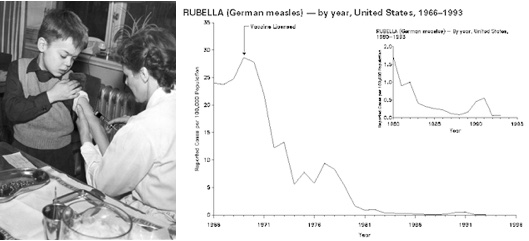
A child receives Polio vaccination in Sweden, 1957; The charted effects of vaccination on Rubella (German Measles) within the United States.
The overall global effects of vaccination are impossible to overstate. Seven diseases have been brought under significant control through the use of vaccines: smallpox, diphtheria, tetanus, yellow fever, whooping cough, polio, and measles. Of these, smallpox has been completely eradicated, saving an estimated 5 million people annually. And polio is currently close to eradication: there were only 416 cases in 2013. According to the World Health Organization, the measles vaccine saves around one million lives annually. Along with clean water supplies, improved nutrition and extensive public health and medical infrastructure, vaccination has been responsible for dramatic declines in deaths from certain infectious diseases. It is thus a central factor in the epidemiologic transition, to an age where non-infectious diseases like cancer, heart disease and diabetes, are the major killers. By 2014, global average life expectancy had risen to 73 for girls and 67 for boys.

